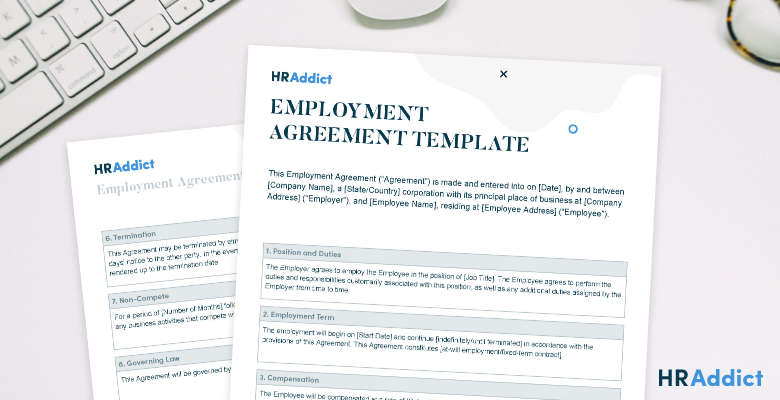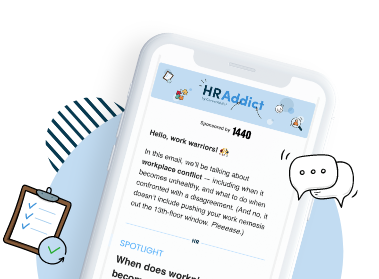You’ve found the perfect candidate suited for your operations! Congratulations!
Do you think a simple handshake between the employer and the employee will suffice? Not in today’s world, when everyone is trying to litigate their way to prosperity or exact revenge on a business that had done the person wrong. It’s a sad indictment on society, but here we are, and it is a matter of adapt or perish. What will your company do?
Indeed, an employment contract is a necessity because everything should always be written and put on paper. But while large companies will typically hire an attorney who specializes in employment law to draft the document, many smaller businesses don’t have the resources to obtain the services of a legal professional. As a result, these enterprises will compose their own agreements.
This might seem like a trying exercise, but it doesn’t need to be. With simple and concise language and knowing how to put it all together, an employment contract can be as easy as signing on the dotted line and finalizing your new hire for the position.
What is an employment contract?
An employment contract is a legally binding agreement between an employer and employee outlining the terms and conditions of employment. It typically includes job responsibilities, salary, benefits, work hours, and duration of employment.
There are different types of employment contracts:
- Permanent contracts, which offer ongoing employment either on a part- or full-time basis.
- Fixed-term contracts, which end after a specific period or project.
- Zero-hour contracts, which provide flexible work without guaranteed hours.
Who needs to sign an employment contract?
Employment contracts should be signed by both the employee and a company representative authorized to sign on behalf of the business, typically someone from HR or a senior manager. This applies to full-time, part-time, temporary, and freelance workers, all of whom are involved in signing contracts.
The employee agrees to the company’s terms, and the employer confirms the offer. Contracts formalize the relationship and ensure that both parties understand their rights and obligations.
The importance of employment contracts
Employment contracts are crucial for several reasons, including:
- Clarity of expectations: They clearly outline the terms of employment, including duties, working hours and compensation, which helps avoid misunderstandings.
- Legal protection: Both the employer and employee are protected by the contract’s terms, preventing disputes over issues such as termination or unfair dismissal.
- Job security: Employees feel more secure knowing the terms of their employment are written down, reducing ambiguity over job roles.
- Compliance with law: Contracts ensure that employers comply with labor laws, including minimum wage, benefits and safety regulations.
- Dispute resolution: In case of disagreements, the contract serves as a reference point for resolving disputes over employment conditions or rights.
How to write an employment contract
Ready to start writing an employment contract? Let’s walk you through the process, step by step.
1. Determine why you’re hiring
To hire the right candidate and put together an appropriate employment contract, it would be a wise idea to sit down with your colleagues and ascertain why you’re bringing on extra personnel. This way, you not only identify why that person is here, but that individual also understands why your company advertised the position.
There could be several reasons for the new employee:
- Your business is expanding
- Your company doesn’t have enough staff to satisfy long-term workloads
- Your firm has opened a position to advance its vision
- Your organization can now concentrate on priorities instead of the small things
- Your enterprise needs a temporary worker to fill in for someone on maternity or paternity leave
Whatever you do, your office should never add an employee because some staff members are complaining about workloads or you have unique projects to complete.
2. Identify your needs
The next step is identifying your corporate needs. This starts by performing an introspection, taking another look at your business objective, mission statement and vision. The following measure is to analyze your data and workflows, which essentially determines if you’re efficient and profitable.
If you’re instituting a collaborative approach to adding staff, then share your information with employees who will likely be engaging regularly with this new hire. Put simply: get their feedback, too.
3. Find inspiration in templates
To ensure that you’re composing the right document, navigate the internet and search for customized templates that are tailored to your industry or business type. This way, you’re following industry standards and determining how a contract should be constructed and what should be included.
Also, by utilizing a template (including the one below), you can and will have a standard employment contract at your disposal at any time without having to write up a new one. It should, however, be noted that it would be prudent to review the template and update it when necessary. Imagine using a document from the 1970s!
If you’re unsure where to look, there are plenty of free resources available to you, including:
4. Prepare a job description
No, we’re not talking about a job description that you will insert into an advertisement. This is a job description that goes in-depth about the position. By taking advantage of this tactic, you know exactly what you’re looking for and what you want in applicants and interviewees. Ultimately, these are the main points you should be adding in your job description:
- Job title
- Type of work performed
- Day-to-day duties and responsibilities
- Skills you’re requesting
- Education requirements you want
- Wage rate (or salary)
- Hours and schedule
EXAMPLE
The Finance Department is requesting the services of an accounting assistant who will work under the supervision of the accounting supervisor. The day-to-day duties involve processing transactions, recording payments, preparing budgetary reports, and fact-checking information with clients, vendors and businesses. This person needs to be analytical, numerical, independent and communicative, possessing postsecondary education in accounting or a relevant field. The position pays $20 per hour for 40 hours a week, from Monday to Friday and 8am to 4pm.
5. Document your policies
Every company needs written policies and procedures that coalesce workplace guidelines, rules laid out by the government, and the principles of the overall business. What your policies are, how you write your procedures and how you implement these measures really depend on your business model.
Indeed, the policies should be followed by everyone: full-time, part-time or seasonal employees, or interns.
That said, it would be important to complete these four simple tasks to complement your employee agreement:
- Prepare policy statement guidelines
- Draft a new hire welcome kit
- Write organizational and policy manuals
- Compose a safety policy statement
6. Identify proprietary information
Do you have proprietary information? This is information that is not available to the public, such as trade secrets, patents or financial data, and belongs solely to the company.
If you know that the new employee will be working with this data, then it would be a good move to protect your company and the individual by making a list that identifies what these may be.
While its definition is wide-ranging, there are many things that fall under its umbrella:
- Secret formulas
- Production methods
- Marketing processes
- Salary structures
- Client lists
- Details of contracts
Legal specialists do recommend that a separate non-disclosure agreement could be crafted. The NDA document outlines what the employee can do with this information and what repercussions could happen should they violate the agreement.
It’s important to remember these two points, as well:
- Ensure you clarify in the NDA that all original works the employee created could be patented or copyrighted, defining who will own the intellectual property rights.
- If the employee is managing social media accounts, then note who maintains ownership of the product.
7. Consult with an employment lawyer
Unless you possess an in-house attorney, your company should retain the services of a lawyer who specializes in employment law. This is a worthwhile investment because you can either have the attorney compose an employment contract, or you can have a lawyer’s opinion about the terms, words and structure of the agreement your firm uses.
8. Write the title
When you proceed to type out your employment agreement, you should title your draft. It doesn’t need to be elaborate; something as simple as “Employment Agreement” or “Company ABC’s Employment Agreement” will do.
9. State the parties
Every employment agreement needs to clearly identify and state the parties. So, in this case, the parties will be the name of your company and the name of the employee. Also, if you operate several locations, then specifically state the business and its location.
EXAMPLE
This employment agreement is between Company ABC (the “Employer”) and John Smith (the “Employee”).
10. List the terms and conditions
The minimum terms and conditions of employment are laid out by federal, state/provincial or local government, and they involve things like vacation pay, severance packages and hours — they vary based on the jurisdiction. Anything beyond these basic labor laws would consist of job responsibilities, dress code, sick days, perks and benefits (health insurance or retirement plans), and other terms.
Now, these are the terms and conditions of employment that the employee will accept when taking a position. Should the employee choose not to sign the agreement, then they will not take the job.
Written terms of employment can protect both the employee and the employer.
11. Outline the position’s duties
To prevent surprises on the part of the employee, and to ensure that the employer gets what needs to be done, the agreement should list the main duties of the position. This comprehensive list should be on a separate outline format that can be attached to the employment agreement for clarity.
Some will also recommend that you try to assign percentages, which is perfectly okay and entirely up to you. It would work by writing (let’s use a casino slot supervisor as an example):
- 50% responding to and resolving guests’ questions, complaints or concerns
- 25% resetting slot machines following payoffs
- 10% monitoring slot machine functionality
- 10% enforcing safety rules
- 5% performing minor repairs casino slot machines
Indeed, determining the percentages of each duty might be difficult, but if you can do it, then it might be a helpful tool for the employer and employee.
12. Be clear on compensation
The compensation aspect of your contract must be clear and direct. This way, there won’t be any confusion or confrontation regarding the employee’s first or second paycheck.
Here are several things to include in your employment agreement:
- Confirm how the employee will be compensated: hourly, salary or commission-based.
- Explain how overtime is calculated (time and a half plus base pay, for example).
- Specify how holiday pay is determined (time and a half for holiday work, for example).
- State how the employee will be paid (check, direct deposit, PayPal, Bitcoin, gold, etc).
- Note if there are paid breaks or annual bonuses.
One more thing: You should include a paragraph that explicitly states that compensation will be re-evaluated in the future. It would be a good idea to also add that this does not a guarantee a raise but that a raise will be considered in the future.
13. Add other clauses
Depending on your business, you might need to consider adding other clauses, too. Here are some of the more important ones to think about inserting into your employment agreement:
- Non-solicitation: A clause that bans employees from soliciting customers in a specific geographical location and employees from leaving the company.
- Privacy: A subsection that clearly states that the employee should have no expectation of privacy regarding employer-issued electronics and emails.
- Probationary: This gives you the right to terminate an employee within a specific period of time without notice.
- Failsafe: A paragraph that confirms you won’t provide anything less than employment standards.
- Non-compete: A clause that prohibits employees from competing with their employer for a specific period of time in a particular location.
14. Use these contract terms
An employment agreement will include several contract terms that should be inserted by the employer:
- Effective date: When the employee agreement officially begins.
- Type of employment: Employment is full-time, part-time, seasonal or temporary.
- Termination: Describe the circumstances in which either the employee or the employer can terminate their working relationship with proper notice.
- Notice: How long it will take to process a legal action by mail or email and when this notice has been received.
- Dispute process: The firm details the dispute process, whether it’s a mandatory arbitration process or the discrepancy is handled in a court of law.
- Severability: this formally states if one part of the agreement is invalid, then the rest of the contract remains intact.
- Applicable law: A mention of the country, state/province or municipality where the contract is effective.
15. Request an attorney review
After you have completed composing the document and have gone through several drafts, you should request an attorney to review the contract.
Unless your best friend in the whole world is a lawyer, you will likely need to pay a lawyer a fee to give it their professional approval. This way, you won’t make any mistakes and be surprised should you face litigation from a disgruntled worker.
16. Include legal boilerplate
Boilerplate text is typically standardized language that you would find in multiple documents. Every legal contract, including your employer–employee agreement, should consist of language that summarizes that completion of the contract and that the legal document coalesces previous oral and written discussions between the two parties.
EXAMPLE
The contract of employment consists of the entire agreement between the parties that supersedes all prior verbal and written agreements or understandings regarding employment of the employee and by the employer. It can be amended or modified only by written instruction that is signed by the two parties.
17. Go over the contract with the employee
Once you have chosen your candidate and you are finalizing the arrangements, be sure to go over the contract with the employee. There are a few ways to handle this part of the process:
- Read over the contract line by line with the employee.
- Have the individual read the contract and initial each page verifying they have read it.
- Ask the person to consult with an attorney to confirm everything is fine.
Employment contract template
Need some inspiration to get started? Check out our custom employment contract template!

Final thoughts
There is a misconception that every agreement needs to be the length of Leo Tolstoy’s War and Peace. Also, there is an idea that every contract needs to be written in Latin, translated into Greek and then converted into English. This is untrue.
For the most part, contracts are not complicated or fancy — they are just specific, and they serve as a tremendous handbook for HR professionals.
Remember: the main aim is to legally protect both parties — and that is all. Nothing more, nothing less.
Here are some final key considerations to keep in mind:
- Give yourself enough time to draft, modify and review the employment agreement.
- Include a signature line and date.
- Add a special section specifically for your sexual harassment policy.
- Place limits on email and internet use to prevent personal consumption.
- Identify how performance will be reviewed and when it will take place.
- Clarify the length of the contract.
- Always provide two copies for the employee and the employer.
Have you ever written an employment contract? Do you have any tips and advice you’d like to share with other small business owners? Join the conversation down below and let us know.
This article is a partial update of an earlier version originally published back in 2019.

